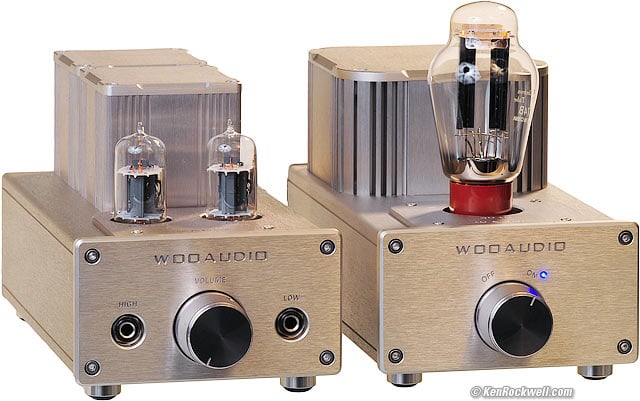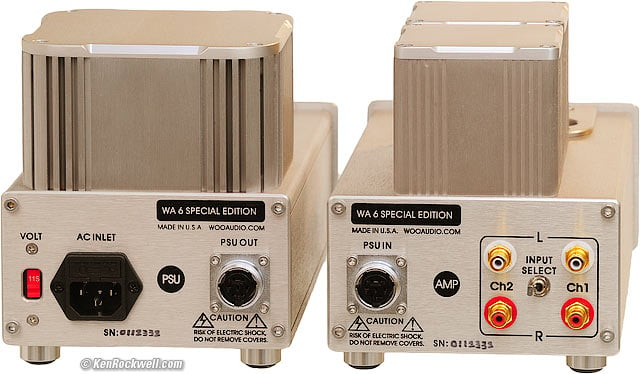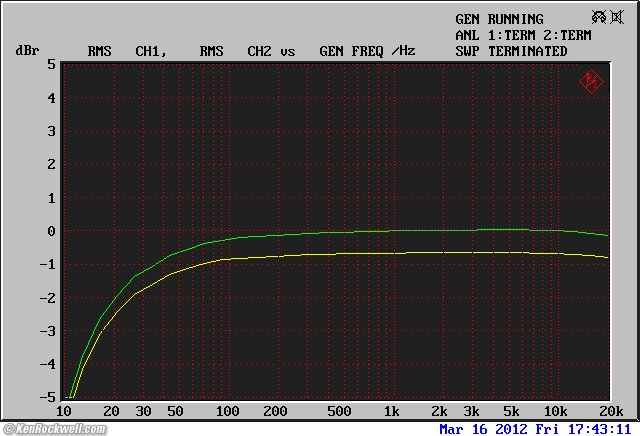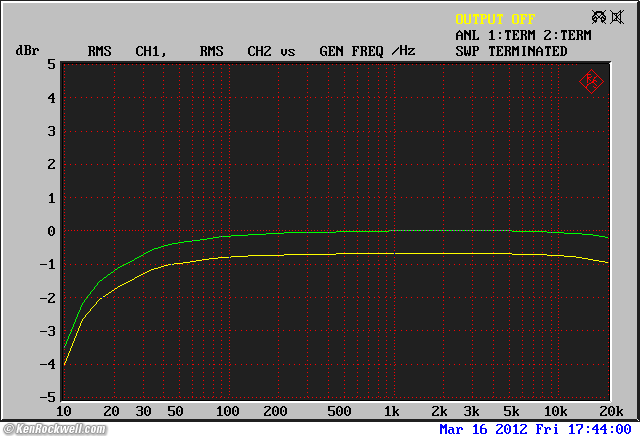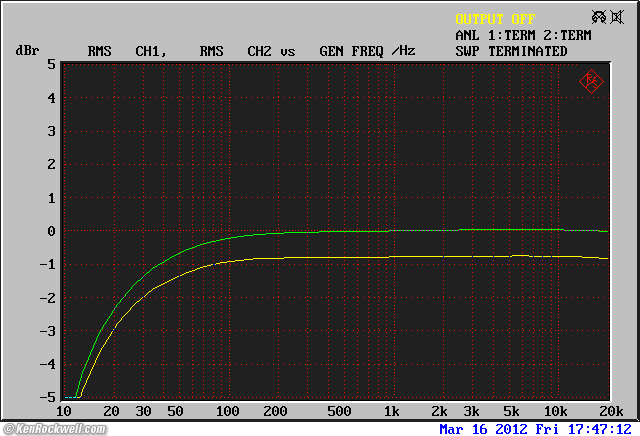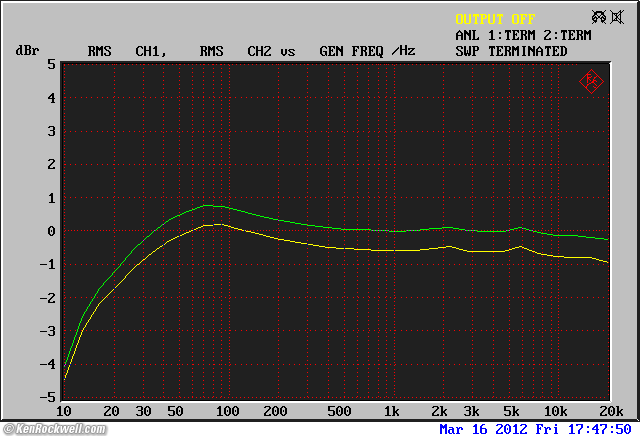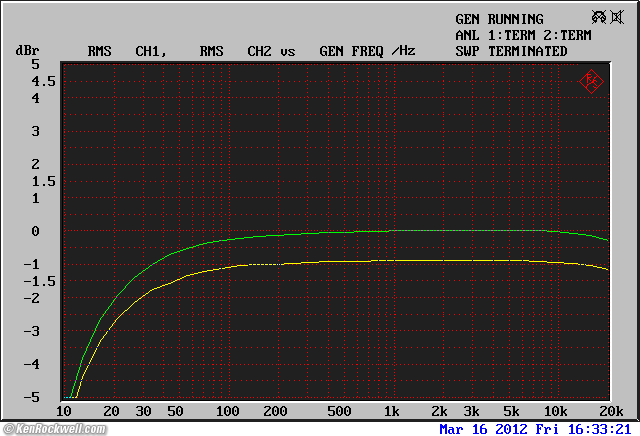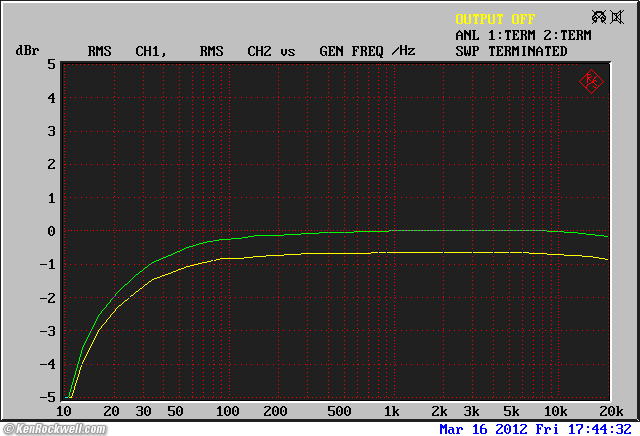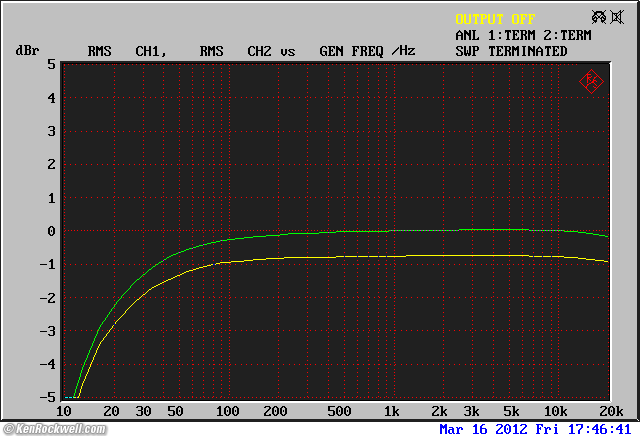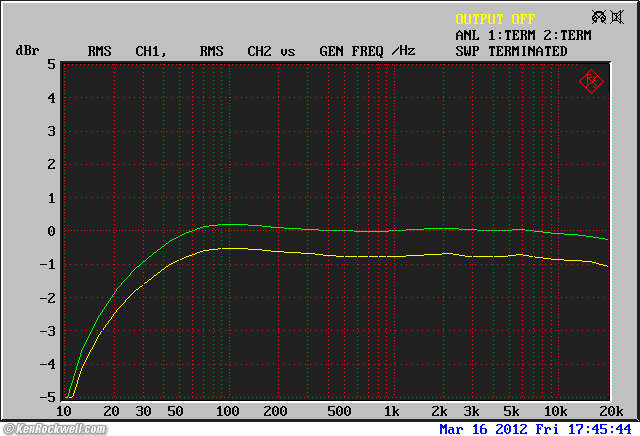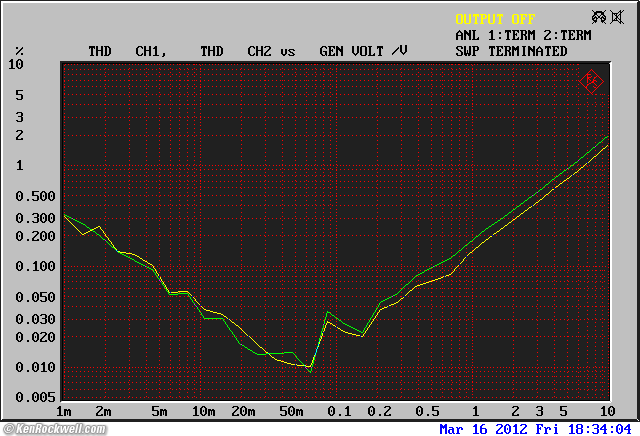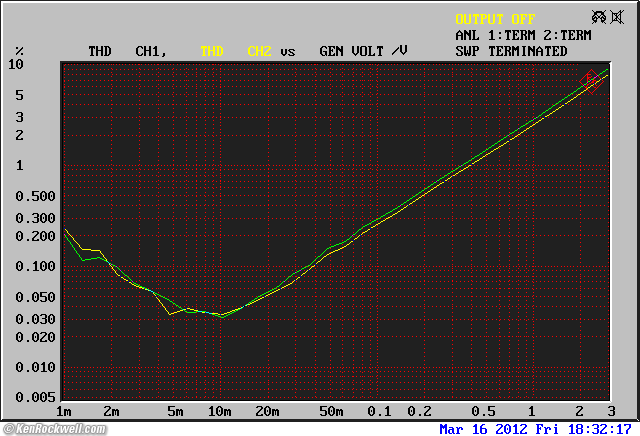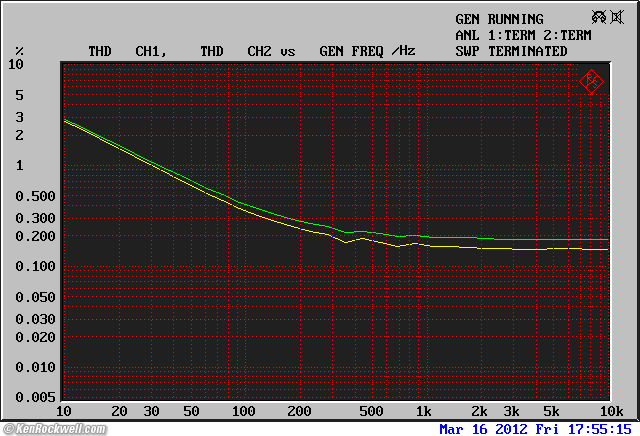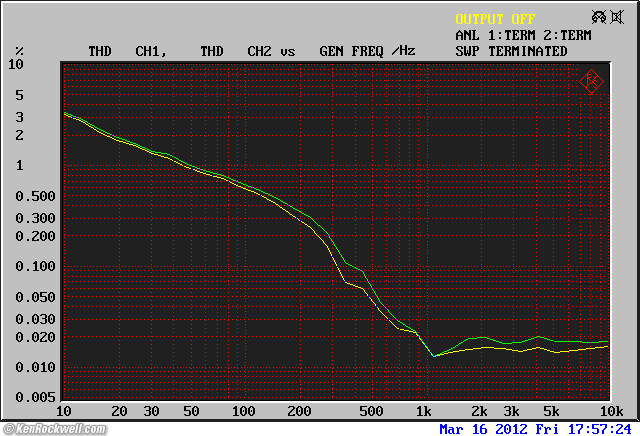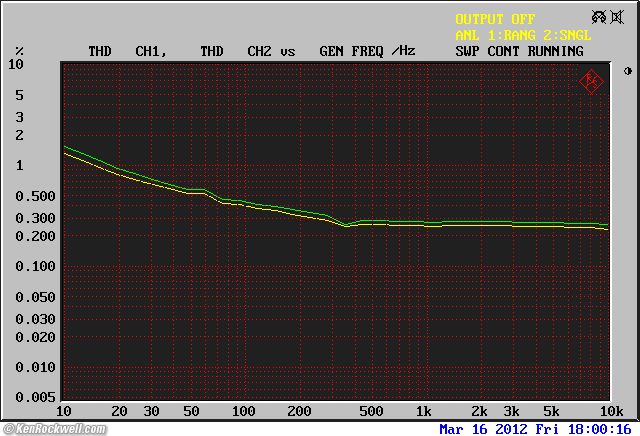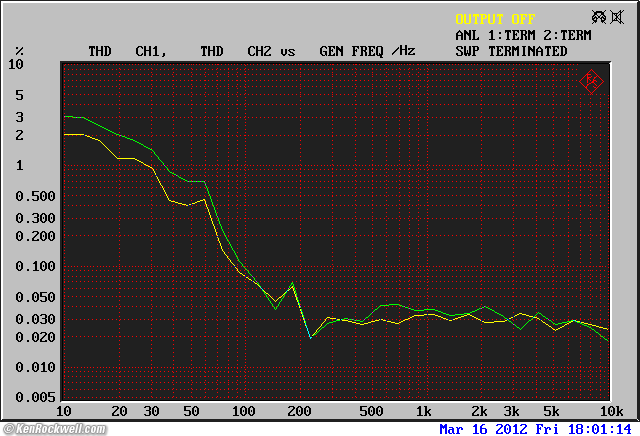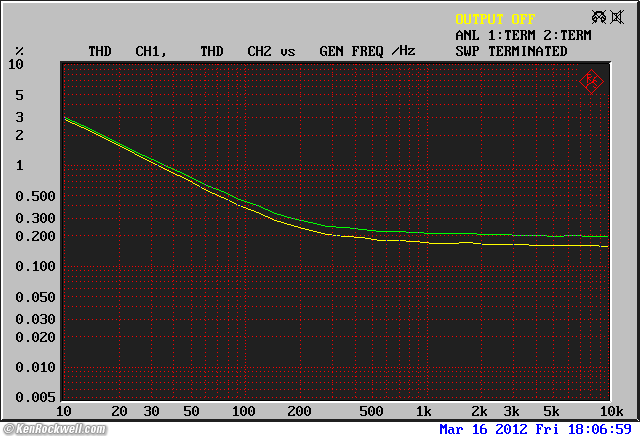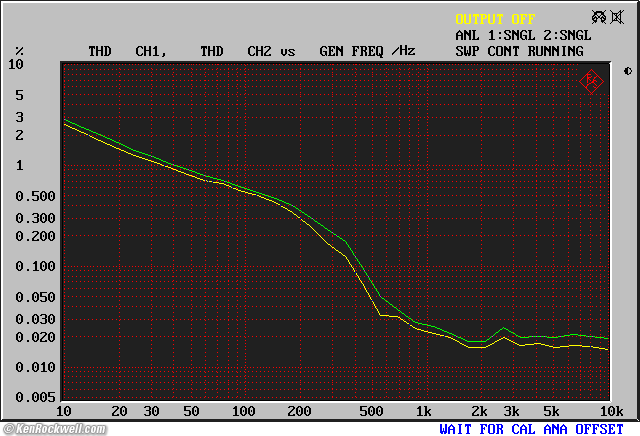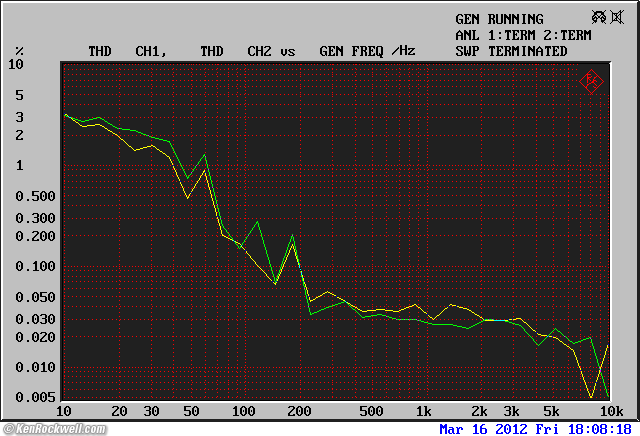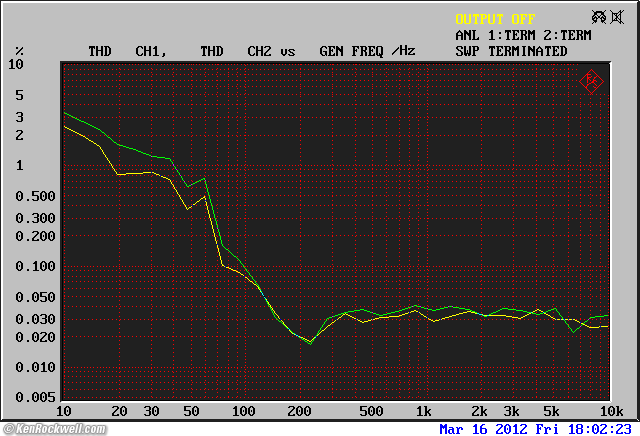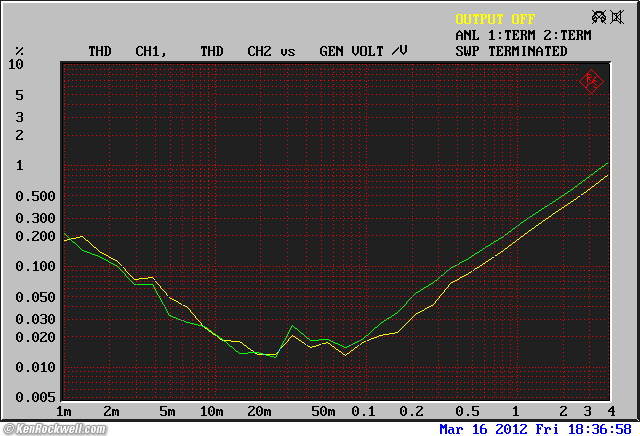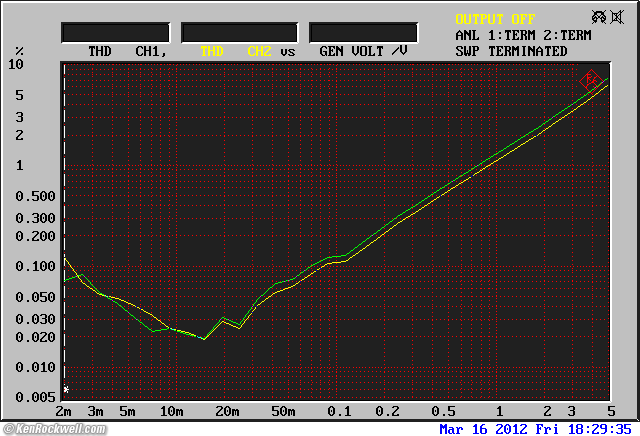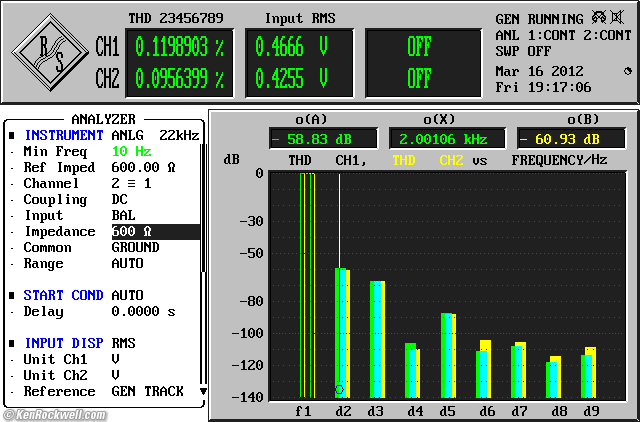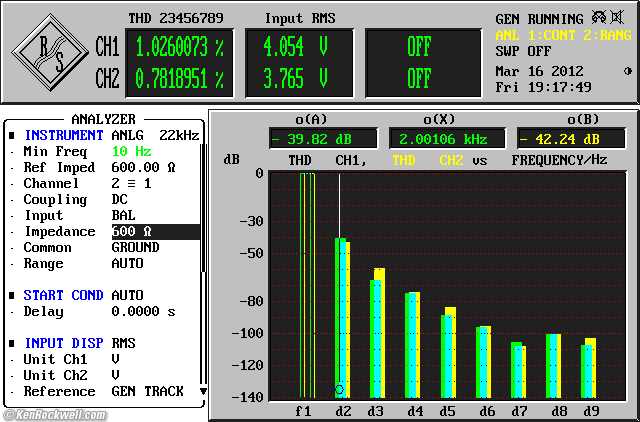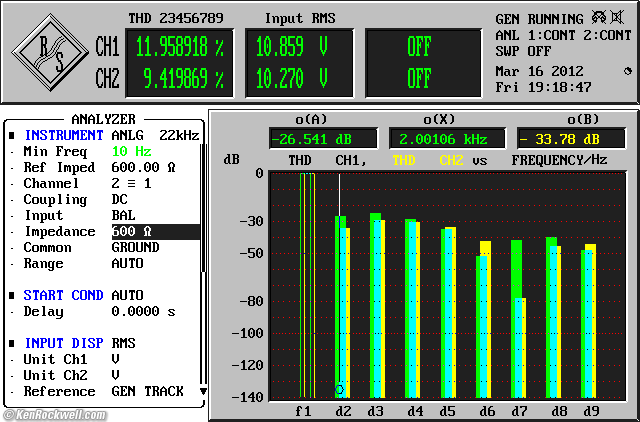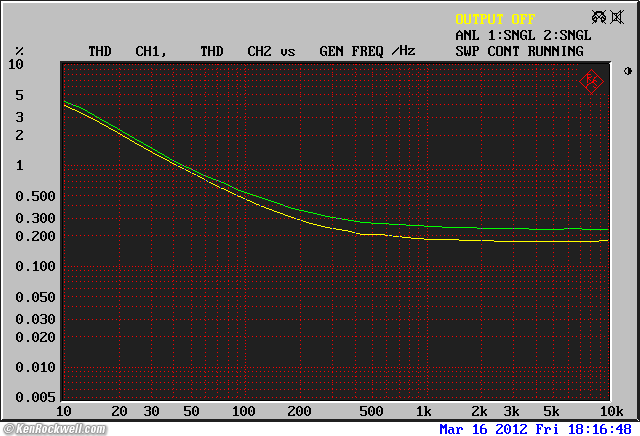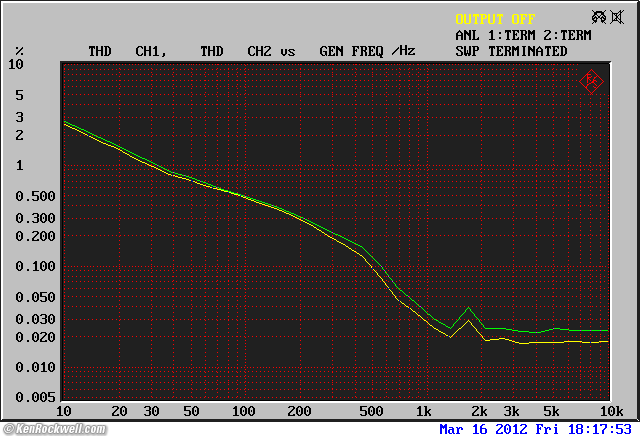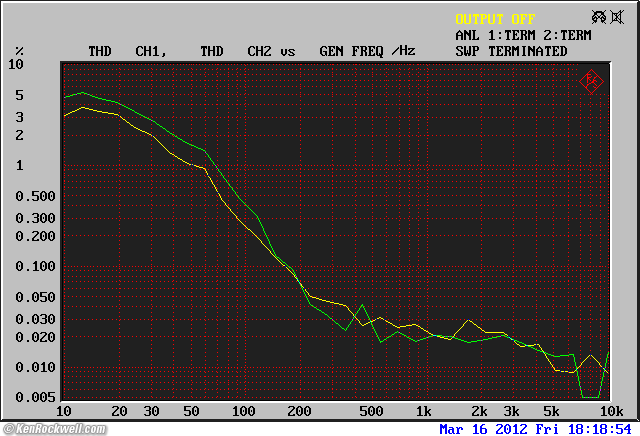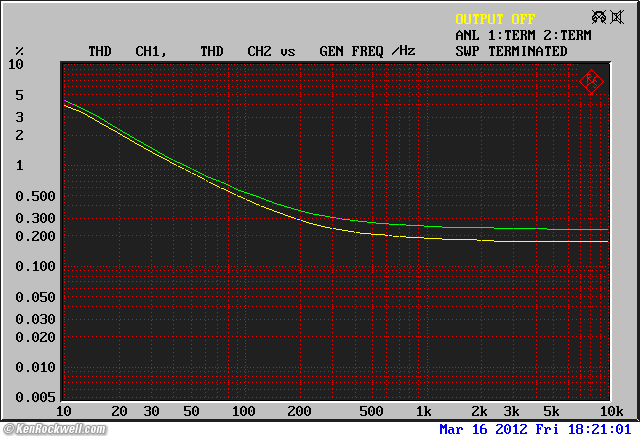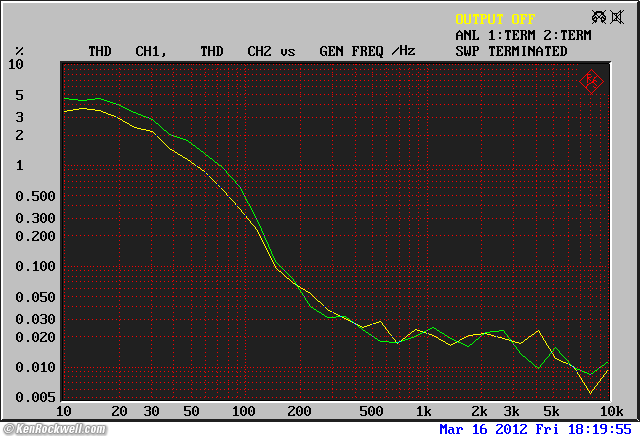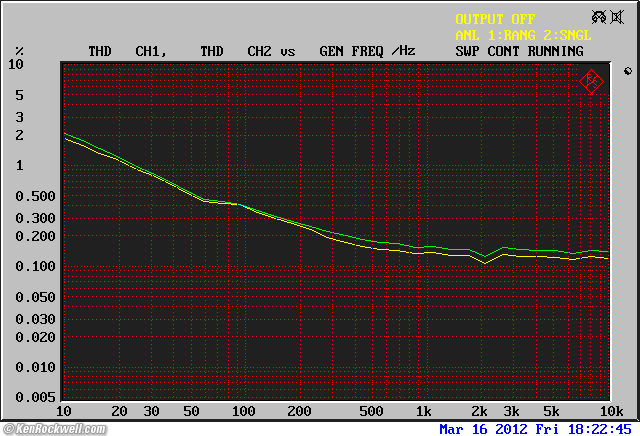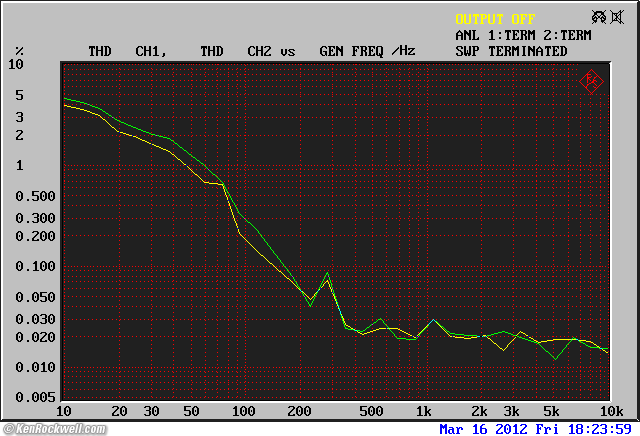Home Donate New Search Gallery Reviews How-To Books Links Workshops About Contact
Woo Audio WA6-SE
Vacuum-Tube Headphone Amplifier
MADE IN USA
© 2012 KenRockwell.com. All rights reserved.
Intro Specs Performance Measurements Usage Recommendations More
Woo Audio WA6-SE and included power supply (about $1,050 the set). enlarge.
Rear, Woo Audio WA6-SE. enlarge. This free website's biggest source of support is when you use these links when you get anything, regardless of the country in which you live. Thanks! Ken.
March 2012 Woo Reviews Headphone Reviews Audio Reviews All Reviews
NEW: Why Tubes Sound Better 27 May 2015
Input: Two selectable inputs, each a stereo pair of ¼" RCA jacks.
Outputs: Two ¼" headphone jacks, one high impedance, one low impedance.
Power: 115 VAC or 230 VAC, switch-selectable, 50/60 cps.
Notable: All-tube, all-analog, all-American made and sold factory-direct for a fraction of the price you'd expect. These are no-BS masterpieces: quiet, stable, loads of gain, no noise, no oscillation, well-designed, well-built and great-handing, great-sounding no-nonsense amplifiers.
Missing: Nothing but the high price. Of course as real, traditional all-analog amplifiers, there thankfully is no digital baloney like remote controls or blinking lights. A loop-through output would have been nice so that it would be easy to insert this amplifier in-line between your sources and your regular preamplifier.
Introduction top
Intro Specs Performance Measurements Usage Recommendations More
|
Adorama pays top dollar for your used gear. I use Adorama, Amazon, eBay, Ritz, B&H, Calumet, J&R and ScanCafe. I can't vouch for ads below.
|
The Woo Audio WA6-SE is a 100% vacuum-tube headphone amplifier. It just works: there's nothing but loads of clean, great sound and great ergonomics. Unlike many of the dinky excuses for expensive amplifiers out there, the Woo Audio WA6-SE is the real thing, loaded with tons of gain ("power"), a big, precise and smooth volume control that allows easy, instant adjustment over a huge range of volumes with no channel imbalance, and no noise, no oscillation, no funny business and no problems — just loads of beautiful, clean music from a perfectly constructed instrument.
The Woo Audio WA6-SE is a real, live American masterpiece, designed, built and sold by the company run by the man who founded it. While some people bemoan how other once-great audio companies like Fisher, B&W and H. H. Scott stopped making great things once their founders passed away, Woo is an American company making great audio products right here in New York City.
The Woo Audio WA6-SE is all audio and no BS. There is nothing "digital" or even transistorized about it. This isn't some whimpy "hybrid" amp with the tubes used only for decoration; even the Woo's power-supply rectifier is a vacuum tube!
Unlike some headphone amps selling for double the price, the Woo amplifiers are built as they should be: hand-made, point-to-point wired (no printed-circuit boards) and all-metal, especially the knobs, switches and transformer covers. All the front-panel and top markings are deeply engraved, not printed. At any price, the Woo amplifiers are precision works of art.
The Woo amplifiers are steals. They are better-made than many far more expensive items, like the made-in-China Krell amps that sell for five times the price.
How can Woo be such a bargain? Easy: Woo sells direct, so you're paying direct. With no expensive middle-men, distributors and dealers expecting 40% margins at every step, you're getting today what would sell for many times more if it were more widely distributed.
If Woo hired a copywriter to spin more audiophile BS and PR about them, he could be asking — and getting — ten times the price.
The WA6-SE reminds me more of the professional broadcast and recording equipment with which I used to work from the 1940s and 1950s; especially with its circular connectors and separate power supplies. Even the pro gear from America's golden age wasn't as well made as this Woo amplifier; the pro gear often made due with printed tube-type markings.
Goodness, I was just looking at the RCA input jacks, and they are stamped WOO AUDIO. Not only that, just like Tektronix test gear of old that always inserted resistors all in the same direction, all the RCA jacks are installed so that the WOO AUDIO lettering, visible only under a magnifying glass, is all oriented in the same direction. Someone there really cares about quality!
Of course the only way you'll appreciate how precisely, solidly and carefully made are these amplifiers is to own one. It all looks the same online, which is why I've gone on about how wonderful it is to see some real gear made without compromise — and when this equipment sells for bargain prices because it's still a relatively less-known brand and sold directly, I'm all over it. The Woo WA6-SE looks professional, not pimped.
Specifications top
Intro Specs Performance Measurements Usage Recommendations More
Color
Silver or black.
Inputs
Two, 100 kΩ each.
Outputs
Two ¼" headphone jacks.
One high impedance, one low impedance.
Output Load Impedance
Rated for 8 ~ 600 Ω loads.
(measured output source impedance is 15 Ω LOW, 50 Ω HIGH.)
Output Power
2 W at 32 Ω.
1.9 W at 60 Ω.
1.8 W at 120 Ω.
1.3 W at 300 Ω.
0.8 W at 600 Ω.
Frequency Response
15 ~ 40,000 cps @ –3 dB.
Distortion
Not more than 0.3%.
Signal-to-Noise Ratio
93 dB.
Tube Complement
5U4G rectifier.
Two 6DE7 or 6CY7.
Power
120/220V, 50-60 cps, rated.
Voltage selector marked 115V or 230V.
Rated power consumption: 44 watts.
Measured power consumption: 49 watts, regardless of load.
Size
6 x 5½ x 13 inches HWD, for each of two units.
Weight
22 pounds combined (10 kg).
Quality
Made in USA.
Performance top
Intro Specs Performance Measurements Usage Recommendations More
Sound
The most striking thing about the sound is how much there is, along with the complete absence of noise or crud. The volume control is the most important control of any amplifier, and in the Woo WA6-SE, the big, glider-smooth pot controls the level easily over a huge range with perfect channel balance.
There's nothing but loads of clean, silent, silky-smooth, airy, wide-stage sound, dependant more on what signals you put into it and what headphones you connect than any sonic distortions from the amplifier.
The WA6-SE has almost unlimited gain and output. Unlike most of the weak excuses for headphone "amplifiers" sent to me for review, the WA6-SE easily can amplify by one-hundred times the power (about 20 dB) or more, and with its superb volume control, is able to adjust this easily to as much or as little as you desire. Other amps, like the Benchmark DAC1 HDR, have a far sloppier and less able excuses for volume controls, and much less gain.
The WA6-SE has enough gain to let me hear noise in just about anything, even with 600 Ω headphones like the Beyer DT880, if I want to turn it up during quiet sections. If you want to drive the WA6-SE with the lower 1 V output typical of portable players like the iPod Touch, it has more than enough gain to hear even the softest passages quite loudly with the Beyer DT880. The WA6-SE is a real amplifier!
The WA6-SE is silent. There is no noise audible at idle, even with extremely sensitive headphones like the Audio-Technica ATH-M50, Beyer T70p and Sony MDR-7506. In fact, the WA6-SE is an excellent way to hear and evaluate what little noise comes out of other components, like the Cambridge Audio DacMagic Plus, which has a slight spurious idle tone at about 1 kc when muted. Any noise you're hearing is in your recording.
Not only is the amplifier's output quiet, the amplifier itself is silent: there is no acoustic transformer or power supply buzz.
The WA6-SE is stable when switching between the two inputs, even if nothing is connected. Unlike many more marginally designed products, switching to an unconnected input simply gives silence, not noise or hum. There is no crosstalk if there's a signal on one input and the other input, even unterminated, is selected. (If you crank the level all the way and select the unconnected input with an input on the other input, you may hear a little something, but don't do this, because you'll go deaf as soon as you realize your mistake and select the correct input!)
The outputs, both LOW and HIGH, are low-source-impedance outputs coupled from the appropriate taps of the output transformer, exactly as they should be. This is far superior to other dedicated audiophile headphone amplifiers at twice the price that use series-resistors to create the "low" output. All a series resistor does is screw-up real-world frequency response and add distortion in the process of reducing the levels for low-impedance headphones, while the WA6-SE does it properly.
The WA6-SE's sound is neutral to very slightly bright depending on your headphones and the output you select. I find the HIGH output with my 600 Ω Beyer DT880 very slightly brighter than I prefer, while the LOW output is neutral with the same headphones. The LOW output is very neutral, similar to Benchmark DAC1 HDR. The balance of the WA6-SE is also very slightly lighter in the deep bass, but that's probably my imagination; I hope I can't hear the measured -1 dB response at 35 cps, but as a bass player, I probably can. Output transformers make it very difficult to get flat response to infrasonic frequencies. There is far more difference from recording-to-recording than 1 dB; if you want great low bass, it's more important to choose recordings with great low bass than to worry about a dB here or there in your amplifier. The magic of tubes is what they do for the 99% of music that lies in the middle. The world went to transistors in the 1960s and 1970s because they were cheaper and measured better for doing crazy things at the fringes of audio, not because they sounded better overall.
Ergonomics
Look and Feel
As I covered above, I wish everything was made this well. Products like the Chinese DacMagic Plus and TASCAM DR-100mkII feel like toys by comparison, and real toys like the Zoom H4n simply feel disgusting. The Woo WA6-SE feels fantastic, and for the price, it's a steal.
The WA6-SE's attenuator is better than a stepped attenuator because it's easy to turn, tracks perfectly and is as smooth as silk.
The power supply's blue pilot LED is almost too bright at night. The blue LED is driven from rectified AC, so it flickers invisibly at twice the power frequency. There's no light on the amplifier other than the glow of the tube's heaters.
The rotary power switch is marvelous; it's so smooth and perfect that I look forward to rotating it just for its own sake.
The inter-unit power interconnection cord is so well designed that its connectors are always oriented correctly for easy connection at either end (they only insert one way).
At first I was afraid that the two-box design would being clumsy, but discovered that it's perfect for desktop use, since the power supply and amp can be placed back-to-back, hiding the power supply at the back corner of your desk, and placing only the half-width amp forward.
Even the metal-holstered rubber feet are great. They're super sturdy because they are surrounded by metal, while the soft rubber tips don't scratch anything.
And did I tell you how much I love the volume control? It needs no clicks, and just spins smoothly and cleanly. The big knob is textured, but still a little slippery — not that your fingers will ever slip because it's so easy to turn.
Power
The WA6-SE has its own built-in power sequencer, so it gradually warms-up over the course of a minute.
This saves the tubes from heavy inrush currents, and saves you from wanting a "pre-heat" switch; it's all automatic. Brilliant!
Measurements top
Intro Specs Performance Measurements Usage Recommendations More
Output Levels Output Impedances Gain Attenuator Tracking
Noise Frequency Response Distortion
I used a $50,000 Rohde & Schwarz UPL audio analyzer to perform these measurements.
The traces are color coded for the Left Channel and for the Right Channel. When they don't lie on top of each other, it's due to channel imbalance.
Output Levels measurements top
HIGH output |
At 0.1% THD |
At 1% THD |
At 10% THD |
600 Ω |
550 mV RMS |
5.2 V RMS |
21 V RMS |
300 Ω |
300 mV RMS |
3.4 V RMS |
20 V RMS |
37.5 Ω |
40 mV RMS |
375 mV RMS |
3.3 V RMS |
LOW output |
At 0.1% THD |
At 1% THD |
At 10% THD |
600 Ω |
440 mV RMS |
4 V RMS |
11.5 V RMS |
300 Ω |
350 mV RMS |
3.5 V RMS |
11.1 V RMS |
37.5 Ω |
90 mV RMS |
880 mV RMS |
6.2 V RMS |
Output Source Impedances measurements top
| Source Impedance | 50 cps |
1 kc |
20 kc |
| LOW output | 14.0 Ω |
15.5 Ω |
15.2 Ω |
| HIGH output | 43.6 Ω |
49.8 Ω |
50.3 Ω |
Gain measurements top
HIGH output |
Maximum gain |
600 Ω load |
23.7 dB |
300 Ω load |
23.0 dB |
37.5 Ω load |
16.7 dB |
LOW output |
Maximum gain |
600 Ω load |
18.5 dB |
300 Ω load |
18.3 dB |
37.5 Ω load |
15.8 dB |
Attenuation measurements top
Volume |
Relative Attenuation |
Maximum |
0.0 dB |
4 o'clock |
-0.8 dB |
3 o'clock |
-3.7 dB |
2 o'clock |
-7.8 dB |
1 o'clock |
-13.2 dB |
12 o'clock |
-16.7 dB |
11 o'clock |
-22.1 dB |
10 o'clock |
-30.0 dB |
9 o'clock |
-38.2 dB |
8 o'clock |
-54.6 dB |
minimum |
-120 dB |
Channel Tracking measurements top
Oddly, the amplifier's channels are always about 0.9 dB off at all levels, which I never heard but saw in the lab when I tested channel tracking.
If we normalize the trace by 0.9 dB, the pot tracks to within ±0.45 dB over a 60 dB range, best I've ever tested for any non-stepped attenuator! By comparison, this is much better than the Benchmark DAC1 HDR if we ignore the constant offset, which I never heard.
Right channel level versus left channel, vs. attenuation setting. (positive means image moves to right. R&S UPL.)
Noise measurements top
Measured at unity gain:
HIGH output (600 Ω load)
-91.7 dBV A-weighted.
-83 dBV unweighted.
LOW output (37.5 Ω load)
-98.0 dBV A-weighted.
-91.0 dBV unweighted.
Frequency Response measurements top
HIGH Output
HIGH-output Frequency Response, 600 Ω load. (R&S UPL.)
Exactly as specified, it's 3dB down at 15 Hz.
HIGH-output Frequency Response, 37.5 Ω load. (R&S UPL.)
Most likely due to the lower source impedance at lower frequencies, the low frequency response is slightly better into a 37.5 Ω resistor than into a 600 Ω resistor. So what; real headphones are far more difficult to drive than resistors.
HIGH-output Frequency Response driving 600 Ω Beyer DT 880. (R&S UPL.)
Perfect! I see no variation in response with real headphones, which I often do with other headphone amplifiers.
HIGH-output Frequency Response driving 32 Ω Ultrasone Edition 8. (R&S UPL.)
As expected, driving the 32 Ω Ultrasone Edition 8 from the HIGH impedance output gives a slight (less than 1 dB) boost at the headphone's resonant frequency of 80 cps.
LOW Output
LOW-output Frequency Response, 600 Ω load. (R&S UPL.)
Same as the HIGH output.
LOW-output Frequency Response, 37.5 Ω load. (R&S UPL.)
Same as with a 600 Ω load, losing the slight low-bass benefit the HIGH output simulated by taking advantage of the lowered low-bass attenuation with low-impedance loads from the HIGH impedance output's lower source impedance. (Hey, this is a free website, so I have no editor to make this make more sense.
LOW-output Frequency Response driving 600 Ω Beyer DT 880. (R&S UPL.)
As expected, since it was fine from the HIGH impedance output, I see no variation in response with the DT880 at the LOW output.
LOW-output Frequency Response driving 32 Ω Ultrasone Edition 8. (R&S UPL.)
Magnificent! Few amplifiers can drive the 32 Ω Ultrasone Edition 8 without adding frequency response errors, and fed from the LOW impedance output, there is only an 0.2 dB rise at 80 cps.
Distortion measurements top
HIGH Output
HIGH-output THD versus level at 1 kc, 600 Ω load. (R&S UPL.)
It's optimum around 10 ~ 200 mV, which is perfect because that's usually where 600 Ω headphones are run.
HIGH-output THD versus level at 1 kc, 37.5 Ω load. (R&S UPL.)
Again, optimum because 32 Ω headphones are usually run at around 10 mV for actual listening.
Good golly; you can tell that this is a real tube amp: the distortion versus level is completely linear for at least 50 dB along this log-log plot. With a "solid state" amp, this trace would be horizontal as levels increased, and then shoot up like a rocket the instant it hit "clipping." This lack of hard clipping is why tube amps have always been favored for music production, especially as guitar amplifiers.
HIGH-output THD, 1 V RMS, 600 Ω load. (R&S UPL.)
As we'll see in all the THD traces, distortion is worst at low frequencies, as we expect for any transformer-coupled amplifier. If you don't like this, Woo makes transformerless amplifiers for less money, but tube amps are about the sound of music, not how well they measure in a laboratory. All these THD traces are plotted here lowered about ten times or more compared to my solid-state and digital audio tests, whose vertical scales usually run from 1% down to 0.0005% instead.
HIGH-output THD, 100 mV RMS, 600 Ω load. (R&S UPL.)
Distortion drops with level, as we expected, while the low-frequency distortion never varies much in any of these traces.
HIGH-output THD, 100 mV RMS, 37.5 Ω load. (R&S UPL.)
HIGH-output THD, 10 mV RMS, 37.5 Ω load. (R&S UPL.)
The distortion traces get lumpier at 10 mV from noise; I'm too lazy to wait around for longer trace times with averaging.
HIGH-output THD driving a 600 Ω Beyer DT 880 at 1 V RMS. (R&S UPL.)
Perfect! I see no variation in THD with real headphones, which I often do with other headphone amplifiers.
HIGH-output THD driving a 600 Ω Beyer DT 880 at 100 mV RMS. (R&S UPL.)
HIGH-output THD driving a 600 Ω Beyer DT 880 at 10 mV RMS. (R&S UPL.)
The distortion traces get lumpier at 10 mV from noise; I'm too lazy to wait around for longer trace times with averaging.
HIGH-output THD driving 32 Ω Ultrasone Edition 8 at 100 mV RMS. (R&S UPL.)
HIGH-output THD driving 32 Ω Ultrasone Edition 8 at 10 mV RMS. (R&S UPL.)
LOW-output THD
LOW-output THD versus level at 1 kc, 600 Ω load. (R&S UPL.)
Beautiful: it's under 0.05% from around 5 mV to 200 mV, which is where 600 Ω headphones are usually played.
LOW-output THD versus level at 1 kc, 37.5 Ω load. (R&S UPL.)
Again, optimum because 32 Ω headphones are usually run at around 3 ~ 30mV in actual listening.
LOW-output THD Harmonic Composition driving 600 Ω at 0.1 % THD. (R&S UPL.)
Golden second-harmonic distortion is 10 dB stronger than anything else, as tubes so proudly boast.
LOW-output THD Harmonic Composition driving 600 Ω at 1 % THD. (R&S UPL.)
Aha, this shows treasured "mostly second harmonic" golden sound of tubes 20dB above other harmonics as the levels get hot!
LOW-output THD Harmonic Composition driving 600 Ω at 10 % THD. (R&S UPL.)
At 10% THD, it's not pretty; what do you expect at 10% THD?
It's interesting to see how linearly distortion tracks signal level. The only reason the left channel appears more distorted in these measurements is because channel imbalance makes it about 1 dB hotter than the left channel.
LOW-output THD at 1 V RMS, 600 Ω load. (R&S UPL.)
LOW-output THD at 100 mV RMS, 600 Ω load. (R&S UPL.)
LOW-output THD at 10 mV RMS, 600 Ω load. (R&S UPL.)
LOW-output THD driving a 600 Ω Beyer DT 880 at 1 V RMS. (R&S UPL.)
LOW-output THD driving a 600 Ω Beyer DT 880 at 10 mV RMS. (R&S UPL.)
LOW-output THD driving 32 Ω Ultrasone Edition 8 at 100 mV RMS. (R&S UPL.)
LOW-output THD driving 32 Ω Ultrasone Edition 8 at 10 mV RMS. (R&S UPL.)
Usage top
Intro Specs Performance Measurements Usage Recommendations More
Don't run the amp without a load! Tube amplifiers hate that. Be sure to turn down the volume anytime you're plugging headphones in and out.
When turned-on, audio comes-up in 20 seconds, but Woo suggests leaving the volume down for a minute after power-on. Woo suggests a 5 minute warm up for best results.
Woo suggests 150 hours of burn-in for best results.
Woo suggests not running for more than 8 hours at a session. When I asked, this is so that amplifiers aren't left on unattended, which can lead to problems when someone unexpectedly comes upon a hot tube amp — OUCH! The amplifiers don't care, but without guards over the tubes, not safe to leave unattended out of common sense.
This is a stable design; there's no manual bias setting needed when changing tubes.
It's rated for headphones as low as 8 Ω, so does this mean speakers? Sure! While not exactly an intended use, I plugged a pair of small B&W 6½" two-way monitors into the headphone jack, and it worked great for desktop use — just don't expect it to go any louder than polite levels, but kept at reasonable levels, sounded great.
Woo says use whichever HIGH or LOW output sounds best to you. While the HIGH output delivers more power into high-impedance headphones, I prefer the sound of the LOW output for my 600 Ω Beyer DT880s, and while the LOW output delivers more power to a 32 Ω or 8 Ω load, the HIGH output even can drive 8 Ω desktop monitors if you prefer it.
For headphones, either output has more than enough power.
I prefer the LOW output for every headphone. I ignore the HIGH output.
Recommendations top
Intro Specs Performance Measurements Usage Recommendations More
Woo makes the best tube headphone amplifiers there are. The WA6-SE has loads of clean, smooth gain and is unaffected by its load.
Great sound is more about good recordings of great music and the right headphones than what sort of amplifier you use — so long as it has enough output and no noise. The Woo WA6-SE sounds airy, light, bright, open and doing all the magic that tube amplifiers are supposed to do, but it can only do it if you've good headphones and recordings of music worth hearing. Don't cheap-out on your headphones if you're investing four-figures in an amplifier; get the HD800s if you want them and never look back.
Don't waste your time with cheap $150 headphones. My personal favorite conventional headphones are the Beyer DT 880, 600 Ω version, a bargain at about $350.
If you're serious enough to be shopping for this thousand-dollar headphone amplifier that plays as well as a $10,000 amplifier for conventional headphones, you may as well go all the way and step up to superior electrostatic headphones, like the Stax, for which Woo is also the USA dealer, and Woo also makes dedicated amplifiers for electrostatic headphones!
If you have $1,000 to spend, I know you're as crazy as I am, and therefore I know you really want the best, which is to buy the Stax and the appropriate amp from Woo Audio.
If you get any of this — and you should — tell them I sent you. As far as I know, your amplifier will be hand-built to your order.
More Information top
Intro Specs Performance Measurements Usage Recommendations More
Woo Audio's WA6-SE Owner's Manual.
Woo Audio's WA6-SE product page.
Woo Audio Amplifier Comparison Chart.
Help me help you top
I support my growing family through this website, as crazy as it might seem.
The biggest help is when you use any of these links to Adorama, Amazon, eBay, Ritz, Calumet, J&R and ScanCafe when you get anything, regardless of the country in which you live. It costs you nothing, and is this site's, and thus my family's, biggest source of support. These places have the best prices and service, which is why I've used them since before this website existed. I recommend them all personally.
If you find this page as helpful as a book you might have had to buy or a workshop you may have had to take, feel free to help me continue helping everyone.
If you've gotten your gear through one of my links or helped otherwise, you're family. It's great people like you who allow me to keep adding to this site full-time. Thanks!
If you haven't helped yet, please do, and consider helping me with a gift of $5.00.
As this page is copyrighted and formally registered, it is unlawful to make copies, especially in the form of printouts for personal use. If you wish to make a printout for personal use, you are granted one-time permission only if you PayPal me $5.00 per printout or part thereof. Thank you!
Thanks for reading!
Mr. & Mrs. Ken Rockwell, Ryan and Katie.
Home Donate New Search Gallery Reviews How-To Books Links Workshops About Contact

